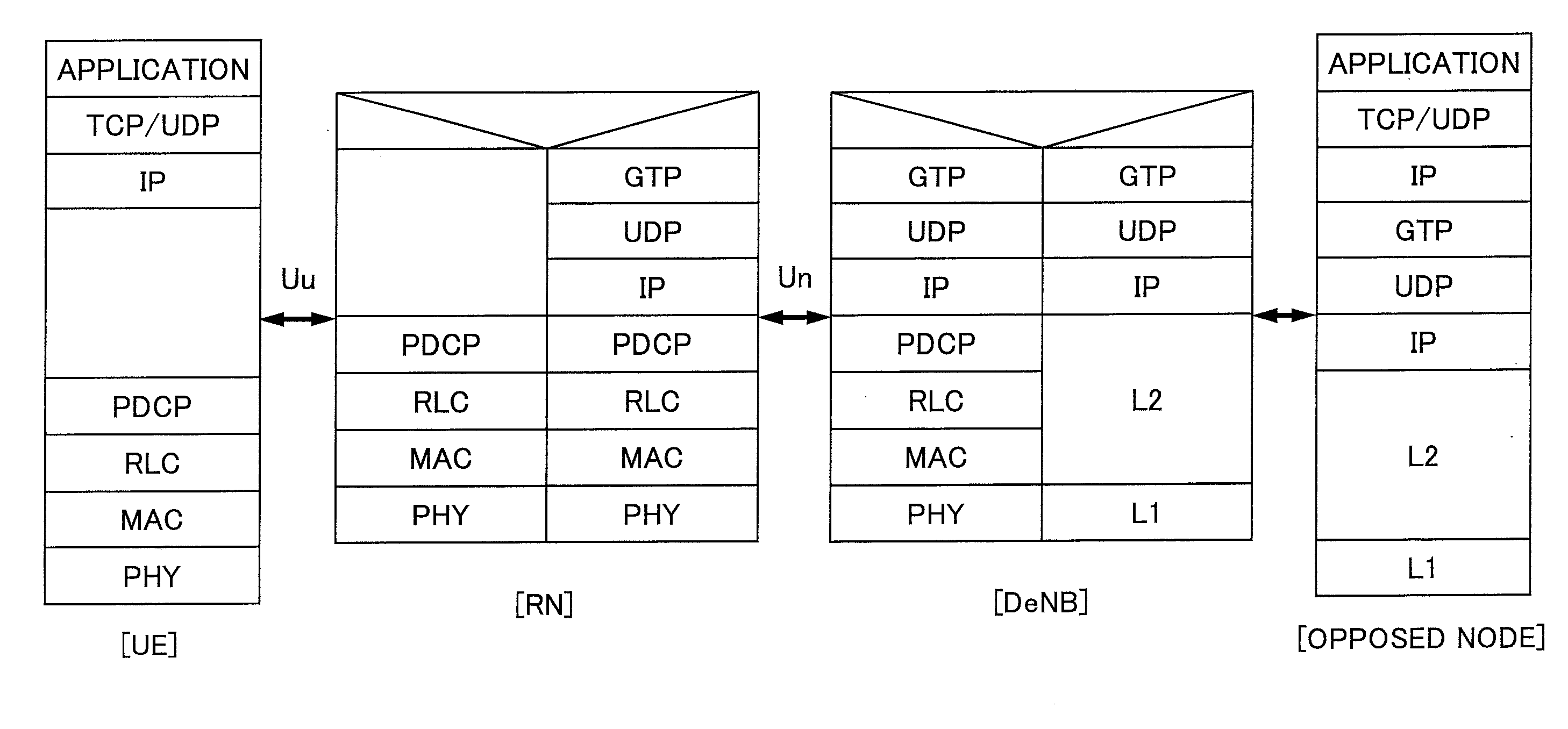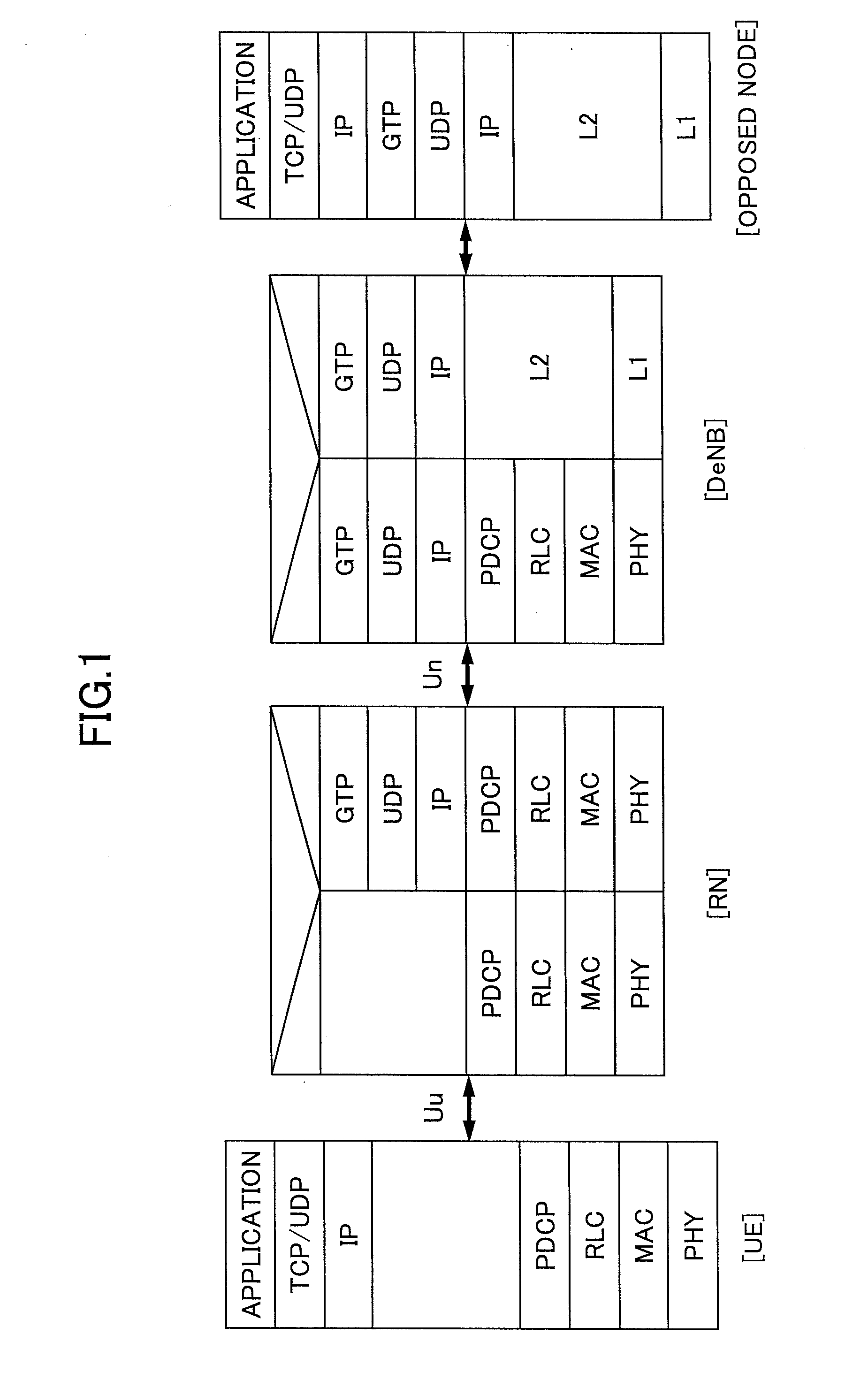Relay station for relaying communication between user apparatus and base station, and relay method
- Summary
- Abstract
- Description
- Claims
- Application Information
AI Technical Summary
Benefits of technology
Problems solved by technology
Method used
Image
Examples
embodiment 1
1. System
[0043]FIG. 2 shows a schematic block diagram of the communication system according to an embodiment of the present invention. FIG. 2 shows a user apparatus (UE) 21, a relay station (RN) 22, a base station (DeNB) 23 and a packet data network gateway (P-GW) 24. As mentioned above, the radio interface between the user apparatus (UE) 21 and the relay station (RN) 22 is referred to as “Uu”. The radio interface between the relay station (RN) 22 and the base station (eNB) 23 is referred to as “Un”. The user apparatus (UE) may be any proper apparatus that can be used by a user for radio communication. The base station (DeNB) manages radio resources in addition to relaying communication between a user apparatus (UE) in a cell and an upper apparatus such as the packet data network gateway (P-GW). The relay station (RN) relays communication between the user apparatus (UE) and the base station (DeNB). The packet data network gateway (P-GW) has a connection function between a mobile co...
first modified example
4. First Modified Example
[0068]The QoS class identifier (QCI) can be set for packets in various methods. For example, QCI may be derived from one or more flow identifiers included in the packet. The flow identifier indicates, for example, a source address (IP address, for example), a destination address (IP address, for example), a port number used for communication, a protocol type used for communication (TCP, for example), DSCP (Diffserv Code Point) value and the like. For example, a predetermined DSCP value or a DSCP value within a predetermined numerical range may be associated with a QCI. As an example, a DSCP value within a range from 23 to 30 is associated with QCI=32. Or, a predetermined destination address may be associated with a predetermined QCI. Further, a combination of a source and a destination may be associated with a QCI. The above-mentioned flow identifier is normally used for filtering (selecting) packets by a Traffic Flow Template (TFT) scheme. In addition, a ne...
second modified example
5. Second Modified Example
[0069]In explanation on FIGS. 3A and 4, a packet generated by the user apparatus (UE) is transmitted to the base station (DeNB) via the relay station (RN) in uplink. The concept of the embodiment can be applied not only to uplink but also to downlink. In this case, although a functional block diagram of the relay station (RN) is similar to one shown in FIG. 4, the packet receiving unit 46 receives a packet from the base station (DeNB), and the packet transmission unit 49 transmits a packet to the user apparatus (UE).
[0070]FIG. 5 shows a flowchart of an operation example in the first modified example, which indicates an operation example of the relay station (RN) in the downlink.
[0071]In step S51, the relay station (RN) receives a packet from the base station (DeNB) via the radio interface (Un).
[0072]In step S52, the relay station (RN) analyzes the received packet, and identifies a QoS class identifier (Un−QCI) set for the radio interface (Uu). The QoS class...
PUM
 Login to view more
Login to view more Abstract
Description
Claims
Application Information
 Login to view more
Login to view more - R&D Engineer
- R&D Manager
- IP Professional
- Industry Leading Data Capabilities
- Powerful AI technology
- Patent DNA Extraction
Browse by: Latest US Patents, China's latest patents, Technical Efficacy Thesaurus, Application Domain, Technology Topic.
© 2024 PatSnap. All rights reserved.Legal|Privacy policy|Modern Slavery Act Transparency Statement|Sitemap



